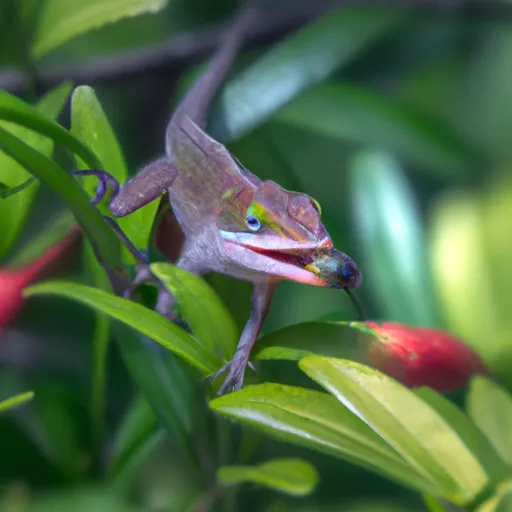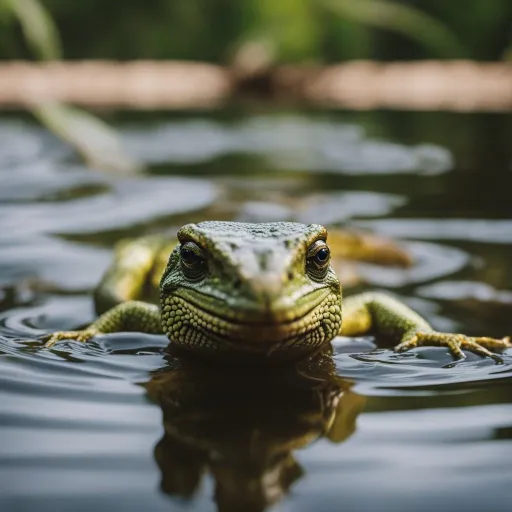If you’ve ever wondered about the eating habits of lizards, you’re in luck. This article will give you a brief overview of how often lizards eat.
Whether you’re a reptile enthusiast or simply curious, understanding the feeding patterns of these scaly creatures can be fascinating.
From the frequency of meals to factors that influence their appetite, get ready to discover the diet of lizards in this captivating article.

Types of Lizards
Lizards are a diverse group of reptiles, and they can be classified into various categories based on their feeding habits.
Understanding the different types of lizards and their feeding preferences can provide valuable insights into their overall behavior and care requirements.
Carnivorous Lizards
Carnivorous lizards primarily feed on other animals, including insects, small mammals, birds, and even other lizards.
These predators have adapted sharp teeth and powerful jaws to capture and consume their prey.
Some examples of carnivorous lizards include monitor lizards, Komodo dragons, and certain species of skinks.
Herbivorous Lizards
Unlike their carnivorous counterparts, herbivorous lizards have a plant-based diet, consisting mainly of fruits, vegetables, and leaves.
Their teeth are designed for biting and chewing plant matter, and they often have specialized digestive systems to break down cellulose efficiently.
Green iguanas and chuckwallas are examples of herbivorous lizards.
Omnivorous Lizards
Omnivorous lizards have a flexible diet that includes both plant material and animal prey.
They have adapted to survive on a broad range of food sources, allowing them to thrive in various habitats.
Many omnivorous lizards exhibit opportunistic feeding behavior, consuming whatever is readily available.
Examples of omnivorous lizards include blue-tongued skinks and some species of geckos.
Factors Affecting Lizard Feeding Frequency
Several factors influence the feeding frequency of lizards. It’s important to understand these factors to ensure proper care and nutrition for your pet lizard or to observe and appreciate their natural feeding habits in the wild.
Species
Different lizard species have varying feeding habits and requirements. While some species may consume small meals multiple times a day, others may only feed once or twice a week.
It’s crucial to research the specific feeding requirements of the lizard species you are interested in to establish an appropriate feeding schedule.
Size and Age
The size and age of a lizard also play a role in determining its feeding frequency. Growing lizards, especially hatchlings, have higher metabolisms and therefore require more frequent meals to support their rapid growth.
Adult lizards, on the other hand, may consume larger meals less frequently due to their lower metabolic rate and reduced energy needs.
Metabolic Rate
Lizards are ectothermic animals, meaning their body temperature is determined by their environment rather than internally regulated like mammals.
As a result, their metabolic rates can vary significantly based on temperature. Warmer environments generally increase the metabolic rate of lizards, leading to higher feeding frequency to meet their energy demands.
Habitat and Environment
The natural habitat and environment in which a lizard lives also impact its feeding habits.
Lizards dwelling in resource-rich environments, such as tropical rainforests, may have a more abundant food supply, allowing for more frequent feedings.
Conversely, lizards in harsher environments or areas with limited food availability may need to adapt to fewer meals or more intermittent feeding schedules.
Seasonal Changes
Seasonal changes can affect the feeding habits of lizards, particularly in regions with distinct seasons.
In colder months or during periods of hibernation, lizards may exhibit reduced feeding or even temporarily suspend eating altogether.
This adaptive behavior allows them to conserve energy when food sources are scarce or weather conditions are unfavorable.
Carnivorous Lizards
Carnivorous lizards have evolved various strategies to capture and consume their prey efficiently.
Understanding their hunting techniques and feeding schedules can provide insights into their fascinating predatory behaviors.
Hunting Strategies
Carnivorous lizards employ a range of hunting strategies depending on their size, habitat, and target prey.
Some ambush predators, like chameleons, rely on stealth and camouflage to surprise their victims.
Others, such as monitor lizards, are active hunters, using their speed and agility to chase down their prey.
Venomous lizards, like the Gila monster, rely on toxic bites to immobilize their victims before feeding.
Frequency of Lizard Predation
The frequency of lizard predation can vary among species and individual lizards. It is influenced by factors such as the availability of prey, metabolism, and the nutritional requirements of the lizard.
Larger carnivorous lizards with higher energy needs may need to consume prey more frequently to sustain themselves, while smaller species may feed less often but consume larger meals.
Feeding Schedule
Carnivorous lizards typically feed when prey is available and when their metabolic needs demand it.
In captivity, pet carnivorous lizards should be provided with a regular feeding schedule that mimics their natural feeding habits.
This may involve offering appropriately sized prey items several times a week, taking into account the specific dietary needs of the species.
Herbivorous Lizards
Herbivorous lizards have specialized digestive systems to efficiently extract nutrients from plant material.
Their feeding patterns and dietary preferences can have significant implications for their overall health and well-being.
Plant Diets
Herbivorous lizards consume a variety of plant material, including fruits, vegetables, leaves, and flowers.
Some lizard species have specific dietary preferences, while others are more generalist feeders.
It is crucial to research the specific plant species that are safe and appropriate for your herbivorous lizard to ensure a balanced and nutritious diet.
Feeding Patterns
Herbivorous lizards may have distinct feeding patterns, often related to their natural environment and the availability of food.
Some species exhibit crepuscular or nocturnal feeding habits, while others are diurnal feeders.
Observation of their feeding behavior in the wild or mimicry of their natural feeding patterns in captivity is important in maintaining healthy feeding routines.
Frequency of Feedings
The frequency of feedings for herbivorous lizards can vary depending on their size, metabolic rate, and specific dietary requirements.
Generally, these lizards may need to eat more frequently than carnivorous or omnivorous species due to the lower caloric content of plant matter.
Daily or multiple feedings per week may be necessary to ensure they receive adequate nutrients for their growth and maintenance.

Omnivorous Lizards
Omnivorous lizards have a versatile diet that includes both animal-based and plant-based food sources.
They exhibit a wide range of dietary preferences and often adapt their feeding habits based on resource availability.
Dietary Preferences
The dietary preferences of omnivorous lizards can vary depending on their natural habitat and available resources.
Some omnivorous species have a preference for insects and other small invertebrates, while others may consume more plant material.
Understanding the specific dietary preferences of your omnivorous lizard will help in providing a balanced and suitable diet.
Feeding Frequency
The feeding frequency of omnivorous lizards may vary depending on their size, metabolic rate, and specific nutritional requirements.
They often exhibit opportunistic feeding behavior, consuming a variety of food sources as they become available.
Providing them with a diverse diet and regular feeding schedule helps ensure they receive the necessary nutrients from both animal and plant sources.
Lizard Metabolism
Lizards have an ectothermic nature, meaning their body temperature is regulated by their external environment.
This, in turn, affects their metabolic rate and influences their feeding frequency and energy requirements.
Ectothermic Nature
Being ectothermic allows lizards to adapt to different temperature conditions, but it also means their metabolism relies heavily on external warmth.
Lizards need to bask in the sun or utilize other heat sources to raise their body temperature, which in turn increases their metabolism and energy requirements.
Effect on Feeding Frequency
Lizard metabolism plays a significant role in determining their feeding frequency. Warmer temperatures often lead to increased metabolic rates and higher energy demands, resulting in a need for more frequent feedings.
Conversely, cooler temperatures can slow down their metabolism, reducing their appetite and lowering their feeding frequency.
Fast Metabolizers vs Slow Metabolizers
Lizards can range from fast metabolizers to slow metabolizers based on their species and environmental conditions.
Fast metabolizers tend to have higher energy needs and require more frequent feedings to sustain their active lifestyles.
Slow metabolizers, on the other hand, have lower energy demands and may feed less frequently to maintain their metabolic needs.
Environmental Influence on Lizard Feeding
The environment has a significant impact on lizard feeding habits. Key environmental factors, such as temperature and seasonal changes in food availability, can affect feeding frequency and behavior.
Temperature and Digestion
Temperature plays a vital role in lizard digestion and overall metabolic function. Lizards are more active and have higher metabolic rates when temperatures are optimal for their species.
Consequently, this increased metabolism increases their energy demands and may lead to the need for more frequent feedings to meet those requirements.
Seasonal Changes in Food Availability
Food availability can fluctuate with the changing seasons, especially in environments with distinct seasonal variations.
Lizards may experience periods of abundance followed by scarcity, affecting their feeding patterns.
During times of plenty, they may feed more frequently to store energy for leaner periods when food is scarce.
Impact on Feeding Frequency
The environmental influence on feeding frequency varies depending on the specific habitat and geographic location of a lizard species.
Lizards have evolved to adapt their feeding habits to survive in their respective environments, adjusting their feeding frequency and behavior accordingly.
Feeding Behavior of Lizard Hatchlings
Lizard hatchlings have distinct feeding requirements and behaviors as they develop and grow. Understanding their specific needs can greatly contribute to their successful rearing.
Frequent Feedings
Hatchling lizards have higher energy demands due to their rapid growth and development. As a result, they require more frequent feedings compared to their adult counterparts.
Daily or every other day feedings may be necessary to ensure they receive the essential nutrients for optimal growth.
Developmental Stages
Lizard hatchlings go through various stages of development, and their nutritional requirements change as they grow.
It is essential to provide appropriate food options and adjust the feeding frequency and portion sizes accordingly to support their specific needs during each stage, from hatching to juvenile and eventually adulthood.
Growth and Nutritional Requirements
Hatchling lizards rely heavily on proper nutrition to support their growth. A well-balanced diet rich in calcium, vitamins, and other essential nutrients is crucial for healthy bone development and overall well-being.
Proper feeding practices during the hatchling stage lay the foundation for long-term health and vitality.
Feeding Patterns of Adult Lizards
Adult lizards have different feeding patterns compared to hatchlings or juveniles. Their size, metabolic rate, and energy requirements tend to stabilize, resulting in distinct feeding behaviors.
Meal Frequency
Adult lizards typically require fewer meals compared to hatchlings. Their lower metabolic rate and reduced energy needs allow for larger meals less frequently.
In many cases, offering appropriately sized meals two to three times a week may be sufficient to meet their nutritional requirements.
Fasting Periods
Some adult lizards exhibit intermittent fasting behavior, where they go without food for certain periods.
This could be influenced by environmental factors, seasonal changes in food availability, or natural adaptations.
While fasting behavior can be normal and healthy for many lizard species, it is important to understand the specific requirements and limits of your pet lizard to ensure their well-being.
Energy Balance
Maintaining an appropriate energy balance is vital for the health and overall condition of adult lizards.
Monitoring their body condition and weight, in conjunction with feeding patterns, helps ensure they receive sufficient food while avoiding obesity or malnutrition.
Adjusting feeding frequency and portion sizes based on their energy needs is key to achieving and maintaining this delicate balance.
Lizard Feeding Adaptations
Lizards have evolved various feeding adaptations that allow them to consume their preferred food sources efficiently.
These adaptations encompass specialized mouthparts, unique hunting techniques, and effective foraging strategies.
Specialized Mouthparts
Lizards possess a variety of mouth structures adapted to their specific feeding habits. Carnivorous lizards often have sharp teeth and strong jaws for capturing and tearing prey.
Herbivorous lizards may have specialized teeth for slicing or grinding plant material. Adaptations in mouth shape, tongue structure, and jaw mechanics enable lizards to extract and process various food sources effectively.
Hunting Techniques
Lizards employ diverse hunting techniques to capture their prey. These techniques range from stealthy ambush strategies to active pursuit.
Some lizards use their speed and agility to chase down fast-moving prey, while others rely on camouflage and patience to ambush unsuspecting victims.
Their hunting techniques often reflect their natural habitat, physical capabilities, and available food sources.
Foraging Strategies
Foraging behavior varies among lizard species, with some being highly specialized while others may exhibit opportunistic feeding habits.
Arboreal lizards, for example, may forage among treetops for insects and fruits, while ground-dwelling species may search for invertebrates in leaf litter or burrows.
The ability to adapt their foraging strategies allows lizards to efficiently locate and acquire food resources in their respective habitats.
Final Thoughts
Understanding the feeding habits and requirements of different types of lizards provides valuable insights into their natural behavior and helps guide their care and feeding in captivity.
Whether you have a pet lizard or are simply fascinated by these intriguing creatures, exploring their feeding frequency, adaptations, and environmental influences enhances our understanding and appreciation of these remarkable reptiles.



